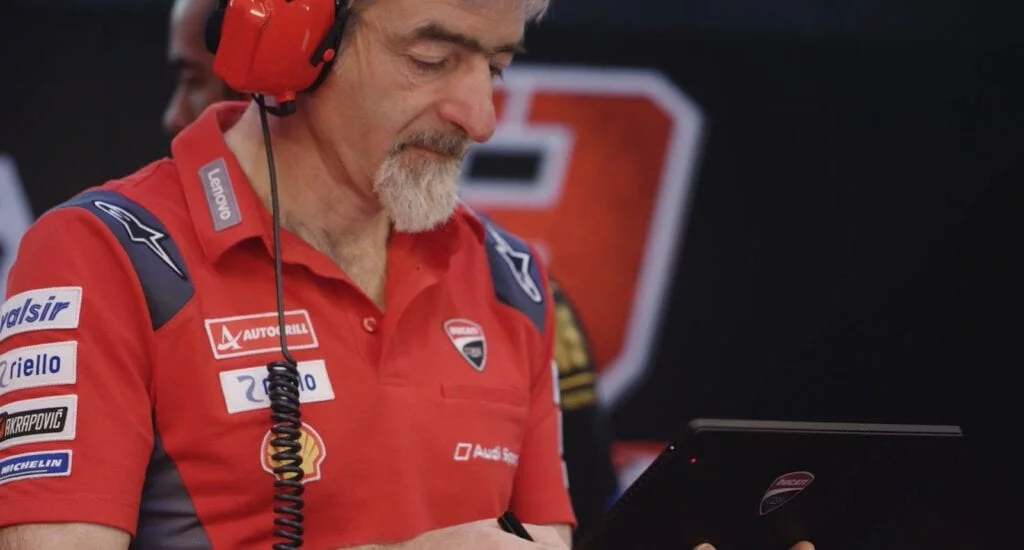In his six years as Ducati Corse’s General Manager, Luigi “Gigi” Dall’Igna has never changed his overarching objective for the legendary MotoGP team.
“The goal is always the same: Win the championship,” he said.

It was the second-to-last day of testing before a race, and engineers were busy making last-minute tweaks to the bikes. As the team inside the garage tinkered, Ducati factory riders Andrea Dovizioso and Danilo Petrucci ran laps around the 5.38-kilometer track outside. Though visible for just a few seconds on the 1.068-kilometer spectator straightaway, you could hear the fierce revving of their engines from miles away.
Amid the frantic action, Dall’Igna retained his signature calm — a composure he’s perfected over nearly thirty years working in motorcycle racing, in which he started as a young engineer. That technical background translates naturally to his role with Ducati Corse, a team known for its advanced applications of technology on and off the racetrack.
Technology is “what makes Ducati a winning team,” Dall’Igna says. In fact, it’s arguably “the strongest point of our team.”

Over the last decade, MotoGP has undergone a technological revolution — spurred in part by Ducati-led innovations — and races continue to get faster, safer and even tighter at the finish line. In such a fast-paced environment, “Data gives Ducati the edge advantage”, explains Gabriele Conti, Ducati’s electronic systems director.
Every Ducati bike is equipped with dozens of micro-sensors that provide continuous feedback on minute data points. The IoT sensors track a host of data points, including tire temperature, revs, engine running parameters and speed, as well as key performance indicators (KPIs) such as vibration, grip and acceleration.
According to Dall’Igna, the team constantly collects “tons of data during tests,” which is then “analyzed to determine the best strategy for the track.” Sand on the racetrack? Sticky brakes? Too much throttle on a turn? Sensors pick up every detail.

With the help of technology, this data directly informs racing engineers’ decisions and dramatically reduces the time it takes to determine and fix any issues with the bike’s performance. Later, engineers apply artificial intelligence and machine learning to the test data and performance KPIs to predict future outcomes and to identify the ideal bike setup. In other words, with every race, the bikes — and the people who work with them — are getting smarter and more adaptive.
While only minor technical changes have been instituted for the 2020 season — including new rules around the evolution of aerodynamics and bodywork — even small tweaks can impact the performance of the bike and rider.
The most significant change for Dall’Igna this season is the sport-wide addition of a new rear tire: the Michelin Power Slick, which the company says is aimed at increasing stability and performance.
“We had to adapt the bike and the entire electronics strategy to it,” Dall’Igna says. “It’s not an easy process.”
That aforementioned process begins with massive data collection, Dall’Igna notes. “We have to see how exactly [the new tire] is working on the track.”
With so much data continuously flowing in from the bikes, Ducati turns to Lenovo’s arsenal of high-performance servers, award-winning PCs and tablets to manage and store it all.
“As you can imagine,” says Paolo Ciabatti, Ducati Corse Sporting Director, “MotoGP is the most advanced motorcycle racing class in the world and there is a lot of electronics in these bikes. Our engineers need to download and process a lot of data, and to do so, we need powerful computers and servers.”
While spectators on the track see the Lenovo logo emblazoned on the front fairing of the Ducati Desmosedici, the technology company is embedded within every aspect of the team, from design and engineering to marketing and management. Ducati officially signed Lenovo as a technological partner and sponsor in 2018.
“Year by year, the role of Lenovo is increasing,” says Gabriele Conti, Director of Electronics Systems. “We are already using the laptops and servers for data, but that is just the first step. Now, we are working on artificial intelligence and big data… Step by step we are growing with Lenovo.”

Engineers use Lenovo ThinkPads in the garage to simulate possible bike configurations — benefitting from the device’s unbeatable durability and battery life — while members of management, like Ciabatti and Dall’Igna, tap away on ThinkPads back at the office to ensure the operation is running smoothly.
Engineers, at the garage, equipped with Lenovo computers download and process data collected from the bikes. This data is then sent to powerful Lenovo servers at Ducati headquarters in Bologna, Italy, for storage and further analysis.
“Our collection of data is increasing year by year — and it impacts every aspect of the race, including simulation development, power control strategies, the braking mechanism, and so on,” Conti explains. He summarizes the role of data as: “Trying to help the human make the right choice” — in the garage and on the track. “Data gives us a huge advantage.”
Lenovo is “the perfect match our engineers need to make these bikes even more competitive,” Ciabatti echoes. “We are proud to have Lenovo branding on our bikes, but on the other side of that, it’s the technological partnership that enables our engineers to develop bikes at this level.”
Dall’Igna, for his part, did not seem much fazed as the final tests wound down for the evening. He’s focused not on this season’s developments, per se, but preserving his team’s continuity.
“Honestly speaking, not much has changed,” he says. “The team is the same, the riders are the same…I think that continuity is really important. It’s necessary to have the same people working together and using the same way of thinking.”
“We are,” he concludes, “a family.”
